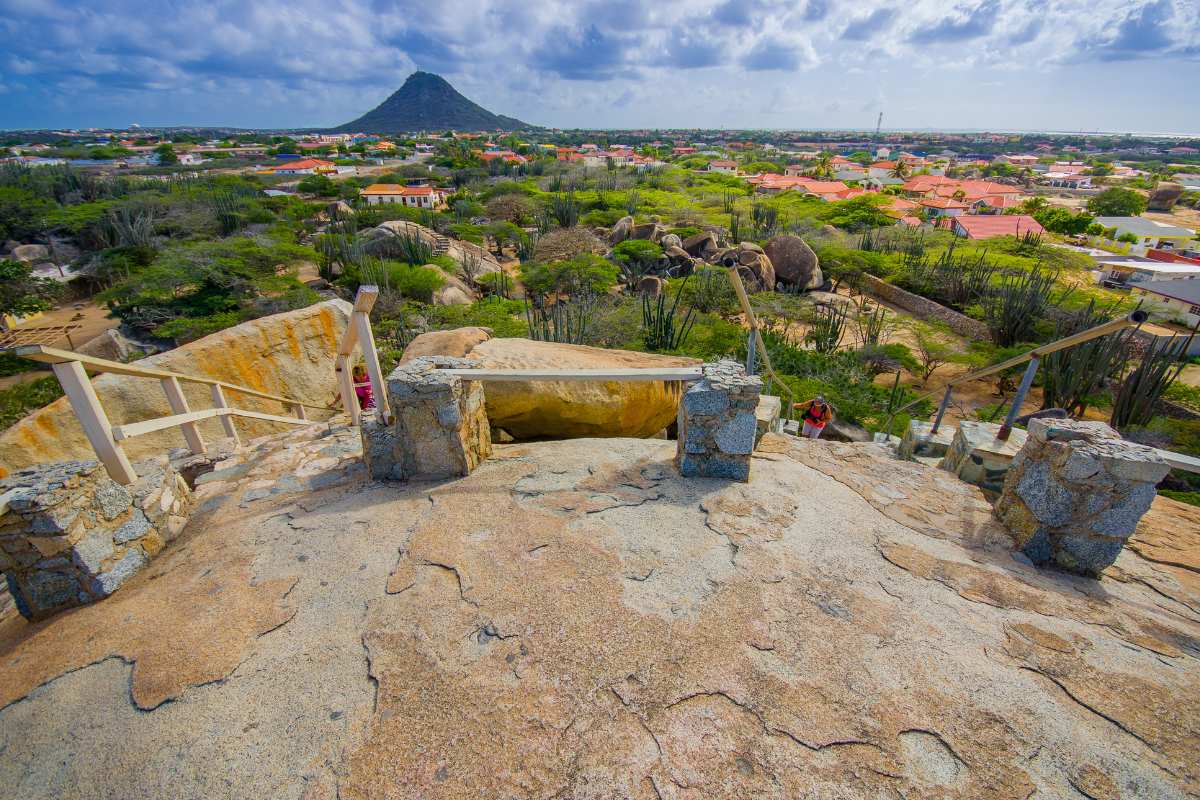Aruba, a beautiful island in the Caribbean, offers vacation-goers a variety of outdoor activities, and one of the most popular attractions is hiking.
With its diverse landscape, Aruba presents a unique hiking experience for nature enthusiasts and adventure seekers alike.
From picturesque beaches to cactus-covered peaks, this island provides several opportunities for exploration and the discovery of breathtaking views.
Hikers in Aruba can choose from a wide range of trails suited for various skill levels.
Some of the most famous locations include:
- Arikok National Park
- Mount Hooiberg
- and the natural pool of Conchi

Each of these spots offers a distinct taste of Aruba’s landscape: the rugged terrain of Arikok National Park, the stunning views from Mount Hooiberg’s summit, and the serene oasis at Conchi.
Whether you’re an experienced hiker or a beginner looking for a leisurely stroll, Aruba’s trails cater to all abilities and preferences.
Find out – What is a Good Hiking Distance for Beginners
With the island’s pleasant climate and picturesque scenery, hiking in Aruba is a must-do activity for anyone seeking a memorable Caribbean adventure.
Getting Started on Your Hiking Adventure in Aruba

Aruba is a picturesque island known for its diverse landscapes, making it an ideal destination for outdoor enthusiasts.
Here are essential steps to help you embark on your hiking adventure in Aruba and make the most of your trip.
Essential Packing Tips
Before starting your Aruba hiking journey, ensure that you have packed all the necessary items for a successful hiking experience.
Here’s a list of essential items to bring:
- Appropriate clothing: Light, breathable clothes, sun hats, and comfortable hiking shoes.
- Sun protection: Sunglasses, sunscreen with high SPF, and lip balm with SPF.
- Hydration: Plenty of water in reusable bottles.
- Food: Snacks or light meals for longer trails.
- Navigation tools: Trail maps or GPS devices to help you find your way.
- First-aid kit: Include basics like bandages, pain relievers, and any personal medications.
As you plan your hiking trip, consider these essential steps:
- Book your travel: Check for available flights to Aruba and book in advance to get the best deals. Ensure that you also have a valid passport and any necessary visas for your trip.
- Arrange for accommodation: Find a hotel that suits your budget and preference. Many hotels in Aruba offer pickup and drop-off services, so make sure to inquire about this during booking.
- Car rental: Although not necessary for all hiking trails, renting a car will give you flexibility if you plan to explore multiple trails or remote locations. Book a rental car in advance to secure your preferred vehicle and avoid any last-minute hassle.
- Choose your hiking trail: Aruba offers a variety of trails, from the moderate Hooiberg hike to the more challenging Arikok National Park trail. Research and select a trail that aligns with your fitness level, preferences, and available time.
Once you’ve completed these steps, you’ll be ready to embark on your thrilling hiking adventure in Aruba and enjoy the breathtaking beauty it has to offer.
Discovering the Unique Environments of Aruba
Aruba, a captivating Caribbean island known for its pristine beaches and vibrant culture, offers a diverse array of fascinating environments to explore.
In this section, we focus on two significant aspects of Aruba’s natural beauty: Arikok National Park and coastal hikes with stunning ocean views.
Arikok National Park and Its Wonders
Arikok National Park covers nearly 20% of the island and is home to a multitude of unique flora and fauna.
The park’s diverse ecosystems include desert landscapes, wildflower fields, and even a hidden natural pool.
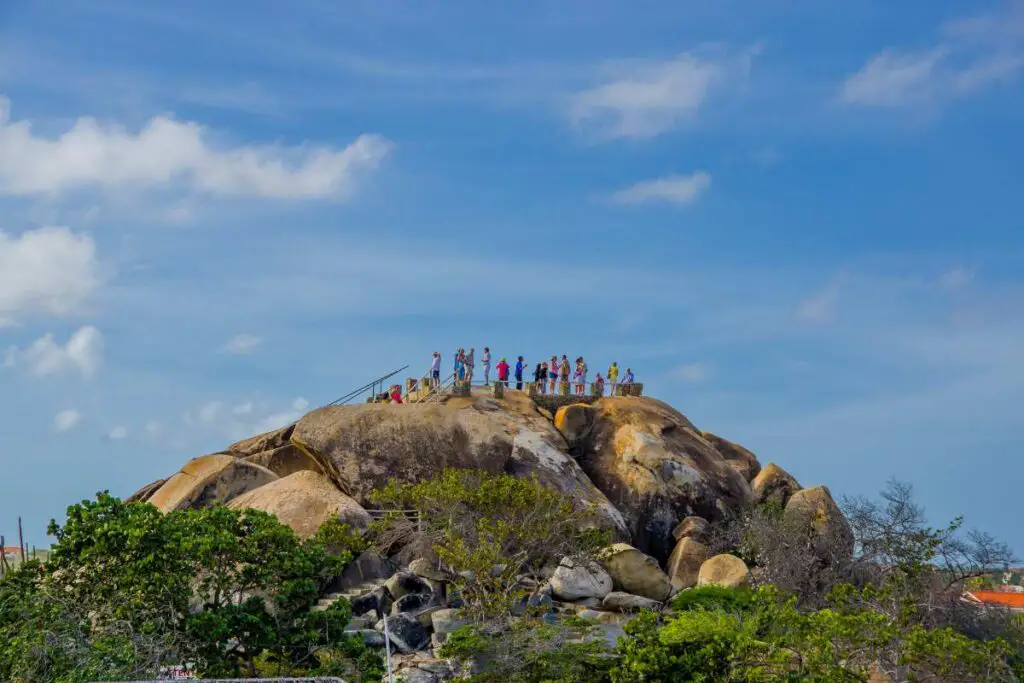
Hikers can traverse the various trails within the park, with Mount Jamanota being the highest point, offering a 360-degree view of the island.
Given the complexity of some trails, it’s recommended to hike with a tour guide for optimal exploration and navigation.
Key attractions within Arikok National Park:
- Desert landscapes: The park features Aruba’s iconic cacti and other desert-adapted plants, creating a unique atmosphere for hikers to experience.
- Wildflower fields: Depending on the season and rainfall, hikers may encounter vibrant fields of wildflowers that add a splash of color to the desert backdrop.
- Natural Pool: Brave the island’s rugged terrain to reach a hidden gem – the enchanting natural pool (locally known as ‘Conchi’), where visitors can relax and take in the beauty of their surroundings.
Coastal Hikes with Stunning Ocean Views
Aside from Arikok National Park, Aruba boasts picturesque coastal hikes that showcase the island’s beautiful shoreline.
One notable hike is Mount Hooiberg, Aruba’s most famous peak, which presents a captivating vantage point of the surrounding landscape.

With roughly 300 painted steps leading to the top, the trail is relatively accessible to hikers of all skill levels.
Other coastal hikes, such as the Spanish Lagoon Mangrove Trail, provide a distinct perspective of marine ecosystems, allowing hikers to discover Aruba’s rare mangrove scenery.
The combination of sandy beaches, rocky cliffs, and the sparkling blue ocean creates an unforgettable experience for nature enthusiasts.
Notable views and elements of coastal hikes:
- Island & Ocean Views: Hikers get to marvel at Aruba’s majestic coastline with unobstructed views of the ocean and neighboring islands.
- Varied Terrain: Coastal trails might include rocky cliffs, soft sand, and even sections of dense mangroves, bringing an air of adventure to hikers.
- Unique Ecosystems: The mangrove trails showcase Aruba’s rich biodiversity, with various marine and bird species to observe throughout the journey.
By exploring both Arikok National Park and coastal hikes, visitors to Aruba will uncover the island’s diverse and breathtaking environments, making for truly unforgettable experiences.
Historical and Cultural Landmarks Along the Trails
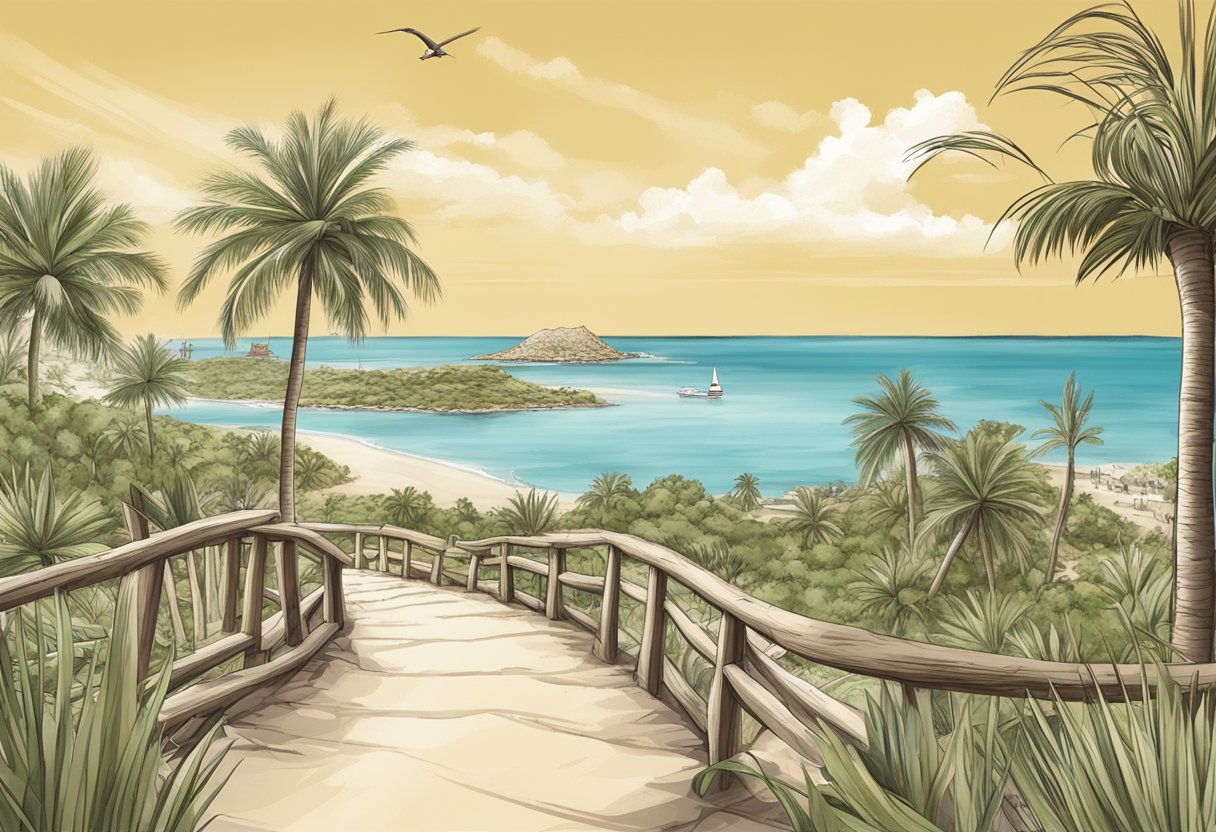
Aruba’s hiking trails offer more than just spectacular natural landscapes; they also provide a means to explore the island’s rich history and culture.
As you traverse these paths, you’ll come across various historical and cultural landmarks that paint a vivid picture of Aruba’s past.
Uncover the Secrets of the Bushiribana Gold Mill Ruins
One notable historical site along the trails is the Bushiribana Gold Mill Ruins.
Located in the northern part of the island, this 19th-century gold processing facility was once a buzzing center for prospectors looking to strike it rich.
As you explore the ruins, you’ll discover remnants of the structures used to process gold ore, providing a glimpse into the bustling days of Aruba’s gold rush era.
The Bushiribana Gold Mill can be found near the Jamanota Trail, allowing you to combine history with hiking as you traverse the island’s highest point.
Reflect at the Tranquil Alto Vista Chapel
Another significant cultural site you’ll encounter along the trails is the Alto Vista Chapel.
Nested in the hills above the city of Oranjestad, this peaceful sanctuary offers a quiet space for reflection and prayer.
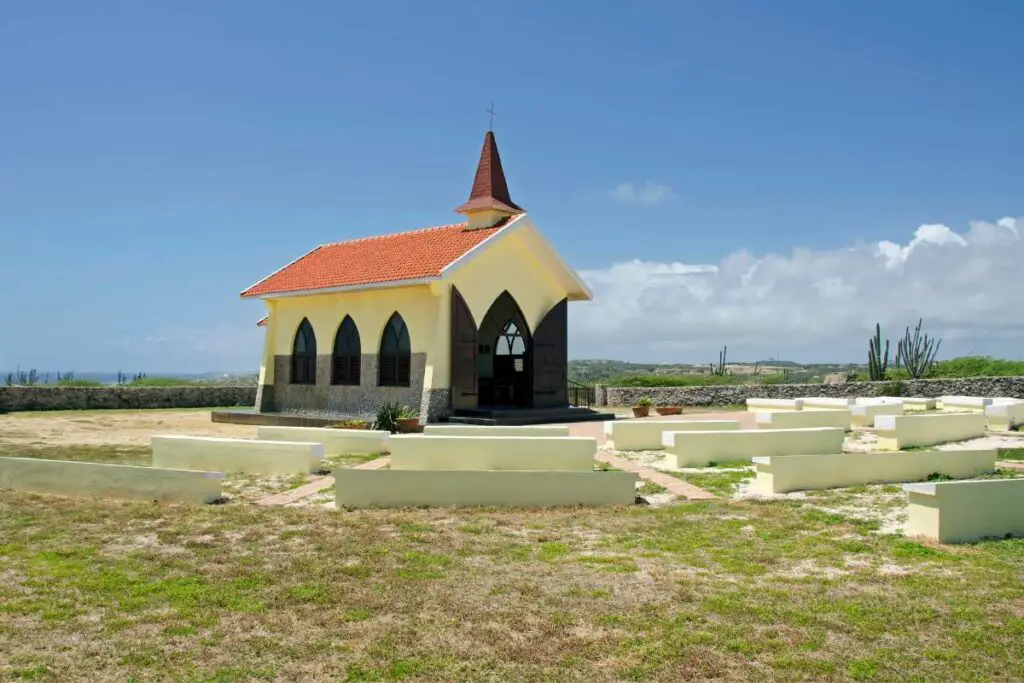
Originally built in 1750, the chapel has been reconstructed over the years, retaining its historic charm. The serene ambiance of Alto Vista Chapel is complemented by stunning views of the surrounding landscape.
To access the chapel, consider hiking along trails near the Arikok National Park or through the Casibari Rock Formations.
Along the way, you may also catch glimpses of the iconic California Lighthouse, another historical monument situated on Aruba’s northwest coast.
By incorporating visits to these cultural landmarks in your hiking itinerary, you can enrich your Aruban adventure with a deeper understanding of the island’s fascinating history.
Additional Activities: See Aruba Beyond the Hiking Trails
Snorkeling in the Warm Caribbean Seas
Aruba offers exceptional snorkeling opportunities for visitors of all ages and experience levels.
The warm, crystal-clear waters of the Caribbean Sea are teeming with vibrant marine life and colorful coral reefs, making it an ideal location for snorkeling enthusiasts.
Many local tour operators offer guided snorkeling excursions, giving you the chance to explore the underwater world at various snorkeling spots around the island.
Don’t miss the opportunity to immerse yourself in this stunning marine environment and witness the diverse aquatic life that calls these waters home.
Family-Friendly Fun at the Ostrich Farm
Another exciting activity to try out while visiting Aruba is a trip to the island’s popular Ostrich Farm.
This unique attraction provides families with an up-close experience of these fascinating birds. Learn about their habitat, behavior, and the differences between ostriches and their smaller relatives, the emu.
Guided tours of the farm are available, allowing visitors to observe the ostriches as they roam about and even participate in feeding these magnificent creatures.
Aside from hiking trails, snorkeling, and the Ostrich Farm, Aruba is also known for other outdoor activities that cater to different interests and fitness levels.
Horseback Riding: Explore the island’s diverse landscapes and scenic views by embarking on a guided horseback riding tour. Suitable for beginners and experienced riders alike, these tours provide an exciting and memorable way to experience Aruba’s natural beauty.
Bike Tours: For those who prefer to explore on two wheels, bike tours are available, giving you the chance to traverse the island’s stunning landscapes, including coastal paths, nature reserves, and picturesque countryside.
Remember that while enjoying these activities, always prioritize your and the environment’s safety by following local guidelines and practising responsible tourism.
Preserving the Natural Beauty: Eco-friendly Hiking Tips
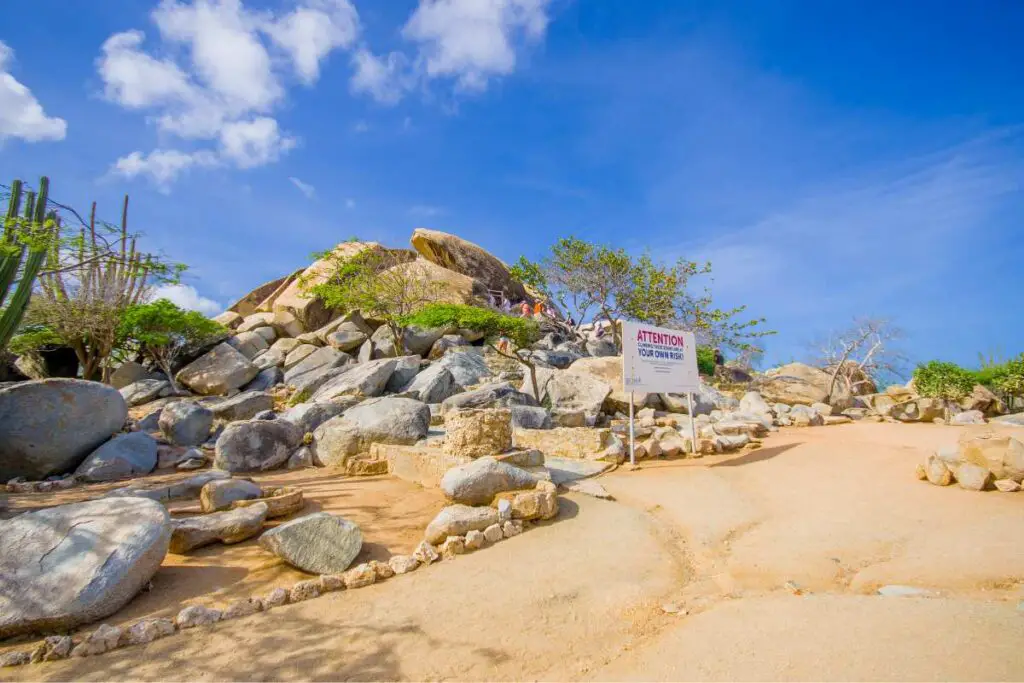
Aruba is home to a diverse range of wildlife, natural wonders, and a unique ecology.
When hiking on this island paradise, it is crucial to treat the environment with respect by following eco-friendly practices.
Here are some tips to ensure that you preserve Aruba’s natural beauty during your hikes.
- Firstly, always stay on designated trails and avoid creating new ones. This helps minimize soil erosion, which can harm the fragile flora and fauna of the island. Staying on designated trails will also help you avoid disturbing wildlife habitats.
- Carrying reusable containers and items can significantly reduce the waste generated during your hikes. Opt for reusable water bottles, silicone camping plates, cups, and cutlery. Reducing trash from the outset helps maintain the cleanliness of the environment, allowing you to fully appreciate Aruba’s natural beauty.
- Practice the Leave No Trace principles, which emphasize taking only photos and leaving only footprints. This means not picking flowers, removing rocks, or disturbing wildlife. By adhering to these principles, you can help preserve Aruba’s unique ecosystems for future generations to enjoy.
- To minimize the impact on Aruba’s environment, use well-made gear made from eco-friendly materials when possible. This includes hiking backpacks, clothing, and footwear made from sustainable sources and designed to last.
- When encountering wildlife during your hike, maintain a safe and respectful distance. This not only keeps you safe but also allows the animals to continue their natural behaviors undisturbed. Be sure to avoid feeding wild animals, as human food can be harmful to their health and alter their behaviors.
- Finally, respect the local ecology by being water-wise. Conserve water by using it efficiently and avoiding excessive use, especially in areas where water resources are limited. Remember that water is a precious resource, and preserving it is an essential part of being an eco-friendly hiker.
By following these simple yet effective eco-friendly hiking tips, you can enjoy the stunning natural wonders of Aruba while minimizing your impact on the environment.
Frequently Asked Questions
What are the best trails in Arikok National Park?
Arikok National Park offers a variety of trails for hikers to explore. Some popular trails include the Miralamar Trail, the Guadirikiri Cave Trail, and the Boca Prins Trail. Each trail has its unique features, such as rugged terrain, picturesque views, and a diverse ecosystem. Be prepared to encounter the park’s stunning landscapes and local wildlife, including Aruba’s national bird – the Shoko.
How do I get to Hooiberg hiking trail?
Hooiberg is the most famous peak in Aruba and is easily accessible from Oranjestad or Santa Cruz. The trailhead is approximately 10 minutes away from Oranjestad by car. Once you reach the base, you will find roughly 300 feet of painted stairs leading up to the viewpoint atop Hooiberg.
What can I expect to see while hiking in Aruba?
Hiking in Aruba offers a unique experience, as you traverse through diverse ecosystems and landscapes. Expect to encounter untouched forests, cliffs, and pristine beaches. Additionally, the island is home to various bird species, local wildlife, and cacti.
Are there any guided hiking tours available?
Yes, guided hiking tours are available in Aruba, allowing you to explore the island’s beauty and hidden gems with the help of experienced local guides. These tours can be tailored to your preferences and fitness level and may include the exploration of Arikok National Park or other popular trails.
What is the difficulty level of Mount Jamanota hike?
Mount Jamanota is the highest peak in Aruba, and the hike can be considered moderate in difficulty. The trail is mostly rocky, with some steep inclines and challenging sections. However, hiking Mount Jamanota is well worth the effort, as it rewards hikers with panoramic views of the island.
Can I explore Aruba’s caves during a hike?
Aruba has several caves that are accessible during hikes. Guadirikiri Cave, located within Arikok National Park, is one such example. Hiking through these caves offers a unique and adventurous experience, as you trek through narrow passages, spot native cave drawings, and admire the geological formations.
